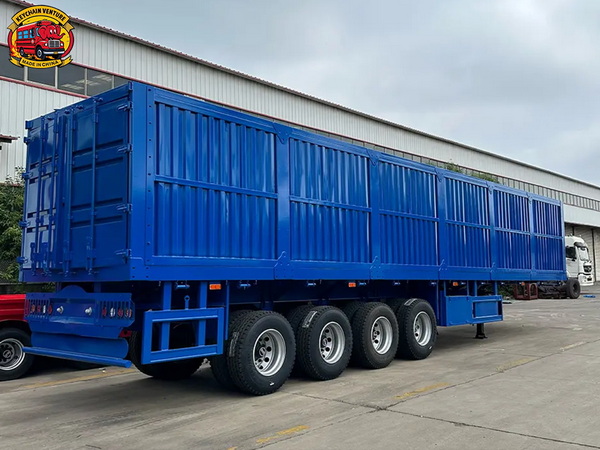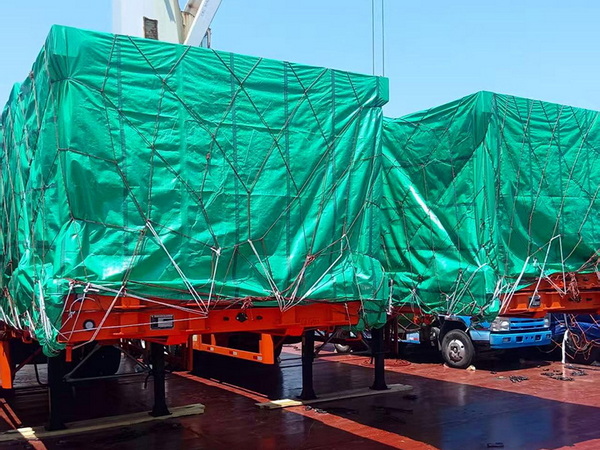Views: 222 Author: Amanda Publish Time: 2025-10-19 Origin: Site








Content Menu
● Physical Factors Affecting Semi Trailer Temperature
>> Trailer Construction and Insulation
● Temperature Ranges Inside Semi Trailers
● Cargo Temperature Requirements
● Cooling and Heating Systems in Semi Trailers
>> Refrigerated Units (Reefers)
● Monitoring and Temperature Control Technologies
● Challenges in Temperature Control
● Best Practices for Managing Semi Trailer Temperatures
● Frequently Asked Questions (FAQ)
>> 1. How hot can a semi trailer get in direct sunlight?
>> 2. What materials provide the best insulation in semi trailers?
>> 3. How do multi-temperature trailers work?
>> 4. What are the key cooling system issues in refrigerated semi trailers?
>> 5. Why is real-time temperature monitoring important?
When considering the transportation of goods, particularly high-value or perishable items, the temperature inside a semi trailer is a critical factor affecting cargo safety, quality, and logistics efficiency. Semi trailers can experience significant temperature fluctuations based on environmental conditions, trailer design, and operational practices, sometimes reaching dangerously high levels that may compromise freight or driver safety. This article delves into how hot semi trailers can get, the factors that influence interior temperatures, and the modern solutions employed to regulate and maintain optimal temperature conditions, ensuring cargo integrity and operational reliability.

The materials used in a semi trailer's construction and its insulation quality heavily impact how much heat builds up inside:
- Insulation Type: Refrigerated semi trailers ("reefers") utilize high-performance insulation materials such as polyurethane foam or composite panels to reduce heat transfer and maintain precise interior temperatures.
- Material Composition: Common semi trailer materials include aluminum, steel, and composite panels. Aluminum is lightweight and moderately insulating, steel offers higher heat retention but also conductivity, while composites provide superior insulation efficiency.
- Trailer Design: The presence of thermal bulkheads and insulated curtains inside semi trailers helps maintain separate temperature zones, reducing heat migration and better preserving temperature-sensitive cargo.
Heat accumulation inside a semi trailer is significantly influenced by external environmental factors:
- Ambient Temperature: High outdoor temperatures during summer can push semi trailer interiors well above the ambient level; temperatures inside can soar between 130°F to 150°F (54°C to 66°C) or more.
- Sunlight Exposure: Direct sunlight exposure can raise trailer temperatures by 20°F to 50°F (11°C to 28°C), intensifying heat buildup.
- Parking Conditions: Parking in shaded or covered areas, or using reflective trailer covers, minimizes solar heat absorption and lowers internal temperatures.
Proper ventilation is vital to mitigating heat accumulation:
- Passive vents allow air circulation and heat dissipation, reducing internal temperature spikes.
- Active ventilation systems, including electric fans or powered extraction units, circulate air to prevent hot spots and maintain more uniform cooling inside the trailer.
Under various conditions, semi trailers can experience a wide temperature range:
| Condition | Internal Temperature (°F) | Internal Temperature (°C) |
| Ambient 80°F (27°C) | 100-120°F | 38-49°C |
| Ambient 100°F (38°C) | 130-150°F+ | 54-66°C+ |
| Direct Full Sunlight Exposure | 150°F (65°C) and above | 65°C and above |
Such elevated temperatures pose serious risks to cargo; perishables, pharmaceuticals, and sensitive electronics may degrade or spoil under excessive heat exposure.
Temperature-sensitive cargo demands meticulous temperature control:
- Fresh produce: Often requires 32°F to 55°F (0°C to 13°C).
- Meat & seafood: Typically needs below 40°F (4°C) or freezing conditions.
- Pharmaceuticals: Must be kept within strictly regulated temperature ranges, many requiring refrigerated transport at 36°F to 46°F (2°C to 8°C).
Failure to maintain these conditions risks spoilage, regulatory violations, and loss of customer trust.

To combat temperature fluctuations, semi trailers are increasingly equipped with advanced climate control technologies:
Reefer trailers are equipped with refrigeration units that actively manage the interior temperature using closed-loop refrigeration cycles. Key components include:
- Compressor: Compresses refrigerant gas, raising pressure and temperature.
- Condenser: Dissipates heat by converting high-pressure refrigerant gas to liquid.
- Expansion Valve: Lowers refrigerant pressure and temperature before entering the evaporator.
- Evaporator: Absorbs heat from inside, cooling the trailer interior as refrigerant evaporates.
These units maintain precise temperatures throughout transit, protecting perishable goods even in extreme weather.
Modern multi-temp trailers subdivide cargo space into several climate zones, enabling transportation of different goods at varying required temperatures within the same trailer. Temperature bulkheads, insulated curtains, and multiple evaporator units enable distinct zones between 2 to 4 compartments, each regulated separately to optimize cargo preservation.
In colder climates or winter deliveries, trailers may incorporate heating units to prevent freezing damage. These systems distribute warm air evenly, employ insulated walls, and integrate precise monitoring to maintain set internal minimum temperatures. This dual-functionality is critical for year-round temperature-sensitive freight transport.
Real-time monitoring and smart controls form the backbone of modern temperature management in semi trailers:
- Temperature Sensors: Placed strategically inside trailers to capture exact temperature data.
- GPS-Enabled Tracking: Combines location with temperature data, providing comprehensive monitoring for fleet managers.
- Automated Alerts: Triggered when temperatures move outside preset thresholds to enable quick corrective action.
- Telematics Integration: Centralized software platforms collect and analyze temperature data across large fleets for efficient operational decisions.
Through these technologies, transportation companies ensure regulatory compliance, cargo safety, and optimized energy efficiency.
Operating a semi trailer with temperature control comes with distinct challenges:
- Heat Buildup: Without sufficient cooling, internal temperatures rise quickly, especially during stops or in stop-and-go traffic.
- Cooling System Failures: Technical issues such as coolant leaks, compressor failures, or thermostat malfunctions can diminish refrigeration effectiveness.
- Energy Consumption: Refrigerated units consume fuel or battery power, affecting operational costs and carbon footprint.
- Cargo Loading: Improper loading blocking airflow negatively impacts temperature uniformity and cooling efficiency.
Proper maintenance, operator training, and system upgrades help overcome these hurdles.
- Invest in High-Quality Insulation: Ensure trailers use composite or advanced foam insulation for effective thermal resistance.
- Use Multi-Temperature Units When Needed: Segregate cargo based on temperature requirements to maximize flexibility and safety.
- Deploy Temperature Monitoring Systems: Install sensors connected to telematics systems for proactive management.
- Optimize Loading Patterns: Arrange cargo to allow adequate airflow and avoid blocking vents.
- Park in Shade and Use Ventilation Fans: Reduce heat gain during stops to preserve internal conditions.
- Regular Maintenance: Inspect and maintain refrigeration units and semi truck cooling systems to ensure operational integrity.
Semi trailers can reach dangerously high temperatures, particularly during summer or direct sun exposure, putting sensitive cargo at risk. To combat this, manufacturers and fleet operators use advanced insulation materials, sophisticated refrigeration and heating units, and real-time temperature monitoring technologies to ensure the integrity of goods and the efficiency of transportation. Maintaining these systems properly and deploying best practices reduce the risk of spoilage, improve energy efficiency, and safeguard public health. Understanding the dynamics of semi trailer heating and cooling allows logistics stakeholders to deliver goods safely and reliably in a temperature-sensitive market.

A semi trailer exposed to full direct sunlight can reach internal temperatures of 150°F (65°C) or higher, significantly above the ambient temperature, which can negatively affect cargo if unmitigated.
Composite insulation panels offer the best thermal resistance for semi trailers, helping maintain consistent temperatures far better than aluminum or steel constructions.
Multi-temperature trailers create separate climate zones within the trailer, allowing different sections to maintain distinct temperatures suitable for varied cargo types via insulated bulkheads and multiple evaporators.
Common problems include compressor failure, coolant leaks, evaporator malfunctions, and thermostat issues, all of which can compromise temperature control and require routine maintenance.
It ensures cargo safety by providing early warnings of temperature deviations, enabling timely corrective actions, regulatory compliance, and reducing product spoilage during transit.
[1](https://www.cargobull.com/use/refrigerated-freight)
[2](https://www.safefleet.net/products/temperature-control/)
[3](https://www.thermoking.com/ap/en/road/trailers/multi-temperature-controlled-units.html)
[4](https://kapitanlogistics.com/en/services/carriage-of-temperature-controlled-goods.html)
[5](https://econtrolsystems.com/solutions/refrigerated-truck-trailer-temperature-monitoring)
[6](https://composite-box.com/blog/ultimate-guide-to-refrigerated-multi-temperature-trailers/)
[7](https://natrailer.com/the-role-of-heated-trailer-solutions-in-winter-deliveries/)
[8](https://www.hegelmann.com/fleet/thermo-trailer/)
[9](https://www.carrier.com/truck-trailer/en/north-america/products/na-truck-trailer/trailer/)
[10](https://gomotive.com/blog/truck-temperature-monitoring/)